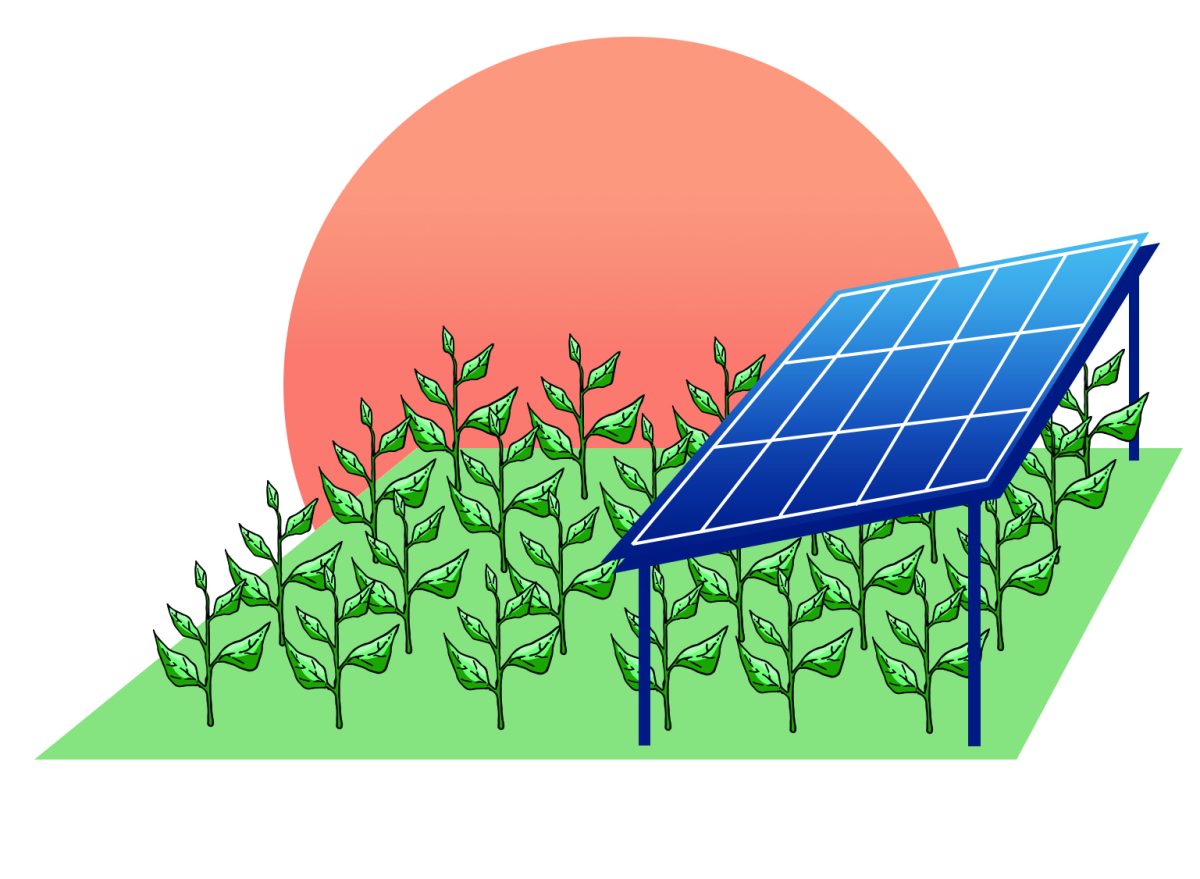Cornell University’s College of Agriculture and Life Sciences (CALS) established an Agrivoltaics Research Program on Dec. 8, 2023 after Governor Hochul signed a bill to fund their research.
Agrivoltaics is the combination of agriculture and photovoltaics. There are three forms of agrivoltaics: pollinator planting around solar panels, animals that graze under the solar panels and using land for both crop production and solar harvesting. In each scenario, the land around the solar panels is used productively and is not wasted.
Henry Williams, a Ph.D. mechanical engineering student at Cornell University, said the research at Cornell University focuses on using the land beneath the solar panels as a place to grow crops.
“Cornell pioneered sheep grazing research through the Cascadilla solar farm project that started a few years ago,” Williams said. “Right now, the focus of agrivoltaic research at Cornell is shifting toward crop production and how we can design solar farms to co-locate crops and produce renewable energy.”
Max Zhang, Irving Porter Church Professor of Engineering in the Sibley School of Mechanical and Aerospace Engineering at Cornell University, said he has been researching agrivoltaics since 2018. In 2020, Zhang received a grant from the New York State Research and Development Authority (NYSERDA) to help fund the engineering side of the research.
“There’s an inherent challenge because both crops and solar panels are competing for the same thing and that is solar radiation,” Zhang said.
Solar power use is on the rise because it does not involve fossil fuels, according to the International Energy Agency. However, the land that solar farms inhabit means less land for farming. Land access remains the top challenge for new farmers, which is why a proposed solution to accommodate both farming and solar energy has begun to grow.
Jeff Bielicki, associate professor in the College of Engineering and the John Glenn College of Public Affairs at Ohio State University, said a concern about agrivoltaics is about the visual problem of using solar panels. He said that even though the solar panels are vaulted above the crops, there is still an added industrial feel to natural farmland.
“There are concerns from people who live on a farm or live in a nearby community and who are used to seeing these amber waves of grain,” Bielicki said. “Now, all of a sudden, they’re seeing all these long rows of metallic shiny things that change the visual aesthetic, which is not fun.”
Agrivoltaics at Ithaca College
Scott Doyle, director of energy management and sustainability at Ithaca College, said he has been learning about agrivoltaics and how the college can learn from this research. He said there are other ways to collect solar energy, like solar panels over parking lots or on top of buildings that Ithaca hopes to have someday.
“I’ve worked with Dr. Zhang and Cornell on a lot of different projects over the years,” Doyle said. “It’s really interesting to learn from them as well as to think about what types of insights they have that might relate to projects we would want to consider doing.”
Floating photovoltaics, placing solar panels on a floating structure in the water, is another recent way to gain solar energy without taking up prime land for agriculture. Doyle said the City of Ithaca is looking into floating photovoltaics for the reservoir on the Six Mile Creek pending further research on the cost-effectiveness and feasibility.
“I’m really hopeful that [agrivoltaics] actually unlocks a lot of opportunities in our rural landscapes to more appropriately balance the important use of natural lands and also energy production,” Doyle said.
New York State’s involvement in the research
New York Senator Michelle Hinchey and Assembly member Anna Kelles collaborated to create the bill and gave Cornell University’s CALS $1 million to help create the program. This bill is another way that New York is working toward its goal of having 100% carbon-free electricity by 2040. The state is also working on wind energy and other forms of solar energy to reach its goal. Hinchey supported this bill during her press release on Dec. 23, 2023.
“The path to solving the climate crisis requires expanding renewable energy projects to achieve our clean energy goals; however, this effort has historically harmed our local food supply, often taking prime farmland out of production and putting farms out of business,” Hinchey said in a press release. “The new Agrivoltaics Research Program at Cornell, CALS, will help change this dynamic by pioneering strategies and technology to facilitate vital collaboration between the renewable energy and agriculture industries.”
Williams said that utilizing more solar farms across the state is a solution to lowering carbon emissions at a timely rate.
“When you look at the numbers, we won’t be able to meet New York state’s renewable energy goals through rooftop, through parking lots, through small reservoirs and so the large-scale solar is necessary to meet the state’s goals,” Williams said. “With that in mind, we’re focusing on how do we make large-scale solar really beneficial to surrounding communities.”
The Agrivoltaics Research Program is not fully in effect yet. The program is in its early stages. Williams said that as the research progresses, they hope to collaborate more with CALS to run crop trials to see what crops grow best under the solar panels and in which climates throughout the country.
“In our lab, what we’ve been doing so far is developing computational tools to enable the design of agrivoltaic solar farms,” Williams said. “We are also evaluating our models with field data, so we’ll go out to commercially operating solar farms throughout the state and record field data with climate monitoring sensors.”
















